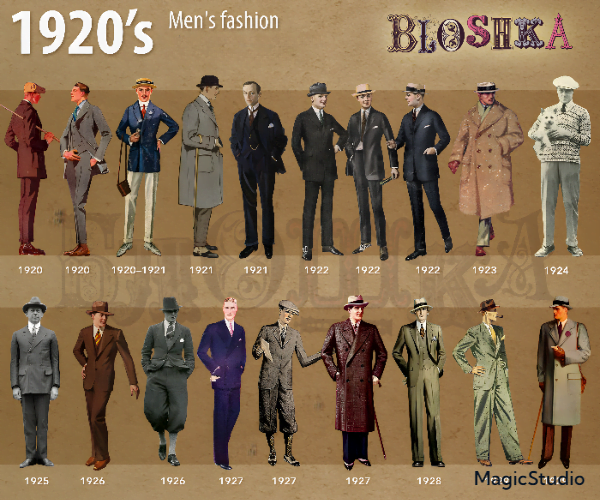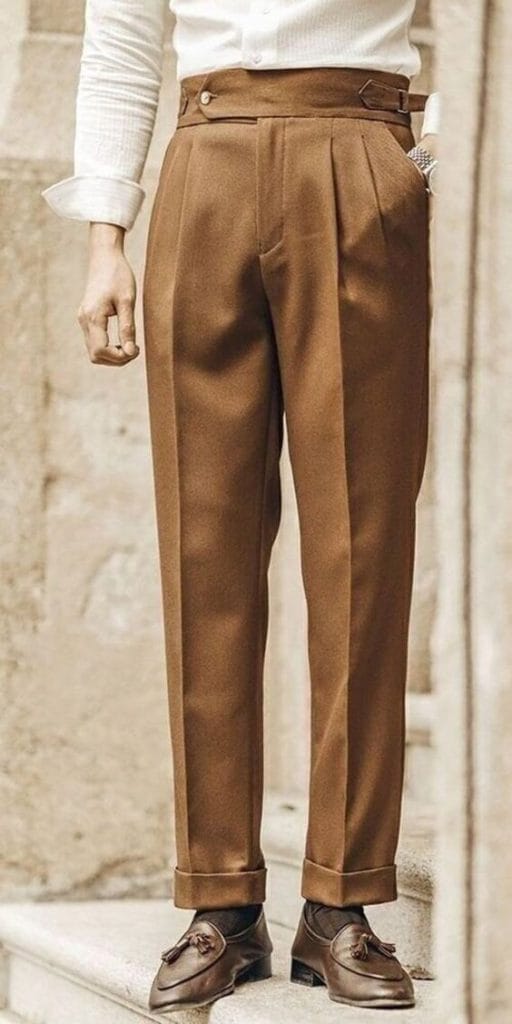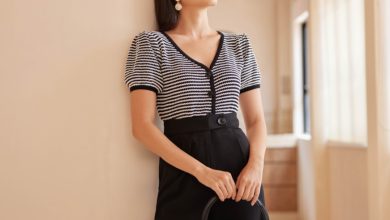Roaring Twenties Outfits for Men: The 1920s Influence on Modern Menswear

Roaring twenties outfits men’s fashion
Fashion is a reflection of the time, and in the Roaring Twenties, America evolved rapidly as a great socio-economic shift swept across the nation. The new freedoms and wealth allowed for more money to be spent on the latest fashion trends. These timeless styles dictated many of the fashion edicts still used today.
After World War I, young people enjoyed themselves and their lives. The people wanted to dress again. Fashion was changing rapidly, and not only for women who had recently won the right to vote but also for men.
Elegant formal wear was now fully functional and perfectly tailored. Men of that era wore form-fitting suits jackets, three-piece suits, and cuffed trousers with creases.
A Brief Overview of Roaring Twenties Outfits Men’s Fashion Evolution
The majority of formal clothing like suits and tuxedos has been around for many years, even centuries. The basic structure of a suit has remained the same for centuries, but the details have changed to meet the needs of people. Fashion was also heavily influenced by the events of that period. Every decade of men’s fashion has a unique style and story.
Media influence and misperceptions
Popular Media Myths and Facts Historical Reality
You may have seen gangster films or Boardwalk Empire and thought that all men wore at the time were pinstripe suits, Tommy guns, and a Tommy gun. They didn’t. We’ll tell you about the real men of old.

Addressing common inaccuracies of era depictions
The 1920s menswear of the day: Fitted jackets that are still heavy, but also fitted.
The jackets from the 1920s were much closer to the body to emphasize the natural waist. They look more like a body coat than a suit today. The buttoning position was lower than in the 19-teens and there were two or three buttons. Some jackets had cutaway fronts, which were probably inspired by the morning coats.
The 1920s button stance is lower than in the previous decade. Sheep’s wool was the most popular fabric, but it was heavier and had a coarser finish than today.

Tweeds Were Less Stiff, but They Were Still Heavier Than Today
Tweed is a popular fabric for country wear. For summer, there are also cotton and linen suits. Fabrics were lighter and less stiff at the time. They were heavy, but not as heavy as they are today.
You might have seen jackets with a more cutaway front in the early 20s or even in the teens. As the decade progressed they became more closed and more like a modern suit. They weren’t squared off, but the fronts were more square than they used to be. If you look closely at these suits, they are very similar to the modern business suit.
There were many patterns to choose from, including windowpanes and stripes, as well as tweeds. Subtle pinstripes are very popular. This is why they appear in so many gangster films.

Roaring twenties men’s outfit essentials: jackets, trousers, and waistcoats
Jackets: Morning Coats, Sleek Double-Breasted Styles, and Diverse Fabrics
The jackets for men in the 1920s were influenced by the morning coats at the time and cut to emphasize waists and create a certain silhouette.
The jackets were usually double-breasted and made of heavier fabrics such as wool. They had a buttoning position between two and three buttons. Sometimes the fronts were cut off and the body was lined with silk. The style is still popular today, despite lighter fabrics being added to the mix.

Trousers: Transition from Flat Front to Pleated and wider Legs
The cuffs of the time were neither tall nor thin. They were modest. I’d guess that they were between one and one-and-a-half inches. The bottom of the trouser leg had grown a bit larger towards the end, but the taper was still there.
In the 1930s you would see more pleats and wider legs in trousers, which led us to Oxford bags.

Waistcoats: New cuts and odd vests are less formal
The lack of a proper heating system also influenced the use of vests to go with suits. Initially, the extra garments were introduced to give the wearer an elegant and fitting look. However, with time they evolved into the best choice for keeping the cold away. Men who did not wear the vest were considered to be underdressed. The most popular choice for formal occasions like weddings and special events was peak lapel vest suits.
This detail would have been visible on the vests. All the men, whether they were from the upper class or the lower class, would wear vests. Vests were also worn to create a slimmer body and highlight the lapels of suits. Double-breasted and single-breasted styles were also popular during that period. The double-breasted vests with their snug fit became a fashion staple and were worn often with single-breasted suits. The use of suit vests began to decline only during World War II when raw materials became scarce.
Shirts and neckwear
Shirts: Soft materials, the decline of detachable collars, and the rise of pastel colors
In the 1920s, shirts were usually solid colors or stripes to make them stand out when worn under jackets and waistcoats. At the end of this decade, men began to wear shirts in pastel colors with single cuffs and turndown colors.
There are still collars that can be removed. They are usually preferred by older gentlemen or men of higher class. The younger men will prefer the turndown collar. Sometimes you can also get an attached collar.
You could choose from single cuffs with cufflinks attached, French cuffs (double cuffs), or double barrel cuffs. Single barrel cuffs were also available that had buttons. Men still wear starched bibs attached to shirts. However, they are not as popular as in the past decades.
Neckwear: The Transformation of Ties
Ties were the accessory that underwent the greatest transformation in menswear. They used to be heavy, poorly made, and wrinkled badly. This hampered a man’s efforts to present a polished image. In the 1920s ties became a more important accessory for men. They were available in a variety of colors, plaids, and horizontal stripes.
Bow ties, made of silk or knitted wool, were also introduced to the mix in order to give men more freedom. In this period, scarves made from rayon or silk and tied in a Windsor Knot were worn under sweaters. Many men also wore collar pins and clips to change up their appearance.
It was easier to tie a pre-tied or clip-on tie in the previous decade when wearing a stiff collar. With a softer neckline, the process was much easier.
Seasonal cycles and formal menswear
Formal attire: Tuxedos and Tailcoats, with an Emphasis on Comfort
In the 1920s, formal events required men to wear a tuxedo or black suit. The tailcoats of the 20s featured a tail on the back. Formal three-piece suits were designed to be more comfortable and moveable.
Black ties are becoming more popular, while white ties are worn at formal events.

Seasonal Fashion Cycles – Bright Suits, Colorful Tweed
The Jazz Age was also introduced in the 20s. This marked the first time that men could loosen their dress code and show off their style by combining tailored separates.
Men wore high-waisted, pleated trousers in a variety of colors, from dark purple to dark green. Corduroy and flannel were popular choices for men who wanted to be more adventurous.

Fabrics, production, and specific fashion elements
Switch to natural fibers
If you had the money, you would line your jacket with silk. The sleeves were made of cotton. You needed something more durable in the arms since that is where things usually wear out first. The arms are also more likely to be dirty or soiled because they sweat more.
Wide trousers and slim silhouettes
The “jazz suit” was another popular style in the 1920s. Their very thin silhouettes and high waists were the most distinguishing features. The idea was to create the perfect hourglass figure.
Jazz suits were popular with younger men because of their slim silhouettes and hourglass shapes.
These novelty suits were marketed and worn by men at the time. It often had a slanted pocket, which created a dynamic that was in line with an hourglass shape. They had to use more darts to achieve this super-contrasted shape. They even used belts, like the Norfolk jacket, to accentuate your waist.

Accessories: Pocket Squares and Watches
Timepieces: Rolex and affordable wristwatches
In the 1920s, soldiers began to popularize watches due to their usefulness. Rolex, as well as other premium retailers, expanded their existing lines to include the first wristwatch made with precious metals.
In parallel, affordable watches for men became a part of mainstream culture.
Pocket Squares
The mass production of pocket squares allowed a wider range of men to wear them. They no longer had wear only plain squares of white linen or cotton. The squares could be printed on silk.
Pocket squares in silk or linen were designed to add a splash of color and class to a suit. Pocket squares are a must for dapper menswear. They can be neatly folded to match the shirt, tie or hat band color.

Footwear and outerwear
Footwear Evolution: Oxfords and Brogues, Sporty Shoes
Boots were less popular than they had been in the 1910s. The streets were cleaner, and there were fewer manures, horses, and other irritants on the street. It was therefore okay to wear regular Oxfords, brogues, or spectators.

Overcoats in muted colors with broad shoulders
The outerwear of the 1920s was more fitted and heavier than today’s clothing. It also came in a variety of darker, muted colors. In the beginning, suits were primarily brown or black, but navy blue became more popular.
Overcoats are usually below the knee, with broad shoulders and lapels. The more luxurious versions have silk lining.

Headwear and Eyewear
Flat Cap Variations
The flat cap was a casual style of headwear that became popular in the 1990s.
It was a flat, round cap that was one piece. It was also wider and looked more like a flat cap today. The flat cap was available in a variety of styles including tweeds and wools, as well as linen and cotton. It also came in a number of different patterns, such as houndstooths, Prince-of-Wales checks, Donegal Tweeds, and more.

Glasses: Upscale accessory with celluloid frames
Celluloids helped create more eyewear styles in the Edwardian period. Celluloid was invented in 1856 as one of the first thermoplastics.
It was originally used as film stock but was then repurposed to create products that looked like tortoiseshell or ivory. This meant that working-class men were able to get the latest style without spending the huge amounts of money they would otherwise have to.

Fashion for Refinement and Practicality
The popularity of tapered trousers and slim fits
The 20s were not just about style and glamour. They also emphasized refinement and practicality. Slim fits and tapered trousers became popular during this period, and they influenced menswear today.
Casual Wear Evolution
In the 1920s, leisurewear and sportswear were introduced. The 1920s saw a shift towards more casual dressing, with the introduction of leisurewear and sportswear.
Conclusion
The 1920s and the Modern Menswear
Roaring twenties men’s outfits have had a major influence on current trends. Comfort and casual clothing were the focus of that era, which led to the development of casual fashion today. Polo shirts, chinos and loafers are all examples of this.
The relaxed shape introduced in the 1920s changed menswear forever. It was also a major influence on modern suits. However, slim-fitted and tailored options are available for those who want a wider range of styles in their wardrobe.
In the 1920s, a variety of accessories became popular that are still in use today. The 1920s style was so confident that it allowed men to fly in any direction they wanted in today’s world.







